
 Turistické a cestovní informace
Turistické a cestovní informace
(Optimalizované pro zařízení s malou obrazovkou)
Pilgrimage Church - Máriagyűd, Maďarsko
Když klepnete:
Klikněte na obrázky!
-
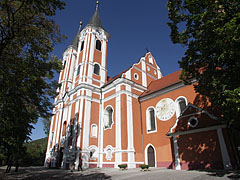
The Roman Catholic Pilgrimage Church of the Visitation of Our Lady in Máriagyűd
Datum fotografie: 3. 10. 20092009
Vytvořil: Robert Németh
Model fotoaparátu: Konica Minolta Dimage A200
Máriagyűd, Maďarsko
-
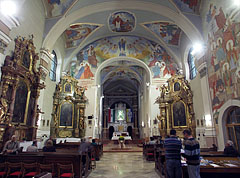
Interior of the Pilgrimage Church
Datum fotografie: 2. 10. 20092009
Vytvořil: Robert Németh
Model fotoaparátu: Konica Minolta Dimage A200
Máriagyűd, Maďarsko
-
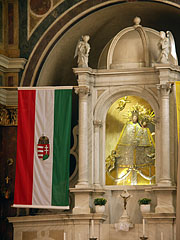
Statue of Virgin Mary on the neo-baroque main altar
It was created in 1862, made of Siklós "marble" (which is in reality a kind of limestone).
Datum fotografie: 3. 10. 20092009
Vytvořil: Robert Németh
Model fotoaparátu: Konica Minolta Dimage A200
Máriagyűd, Maďarsko
-
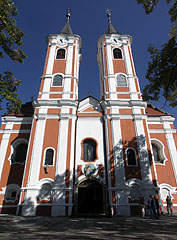
The baroque Roman Catholic pilgrimage church, dedicated to the Visitation of Our Lady
Built by the Franciscans in 1742
Datum fotografie: 3. 10. 20092009
Vytvořil: Robert Németh
Model fotoaparátu: Konica Minolta Dimage A200
Máriagyűd, Maďarsko
-

Towers of the Basilica and Pilgrimage Church of Virgin Mary at the foot of the verdant Tenkes Mountain
Datum fotografie: 3. 10. 20092009
Vytvořil: Robert Németh
Model fotoaparátu: Konica Minolta Dimage A200
Máriagyűd, Maďarsko
-

A stone pit (a mine) on the hillside, and in the foreground grapevines can be seen
Datum fotografie: 3. 10. 20092009
Vytvořil: Robert Németh
Model fotoaparátu: Konica Minolta Dimage A200
Máriagyűd, Maďarsko
-

Restaurant terrace
Datum fotografie: 3. 10. 20092009
Vytvořil: Robert Németh
Model fotoaparátu: Konica Minolta Dimage A200
Máriagyűd, Maďarsko
-
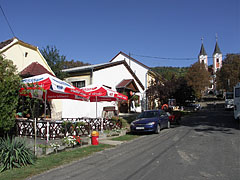
Street view with restaurants and the Pilgrimage Church
Datum fotografie: 3. 10. 20092009
Vytvořil: Robert Németh
Model fotoaparátu: Konica Minolta Dimage A200
Máriagyűd, Maďarsko
-
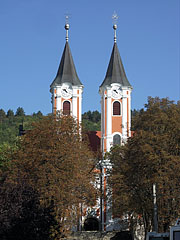
The towers (steeples) of the Pilgrim Church through the trees
Datum fotografie: 3. 10. 20092009
Vytvořil: Robert Németh
Model fotoaparátu: Konica Minolta Dimage A200
Máriagyűd, Maďarsko
-

Statue of St. Francis of Assisi (founder of the Franciscan Order) in the garden of the pilgrimage church
Datum fotografie: 3. 10. 20092009
Vytvořil: Robert Németh
Model fotoaparátu: Konica Minolta Dimage A200
Máriagyűd, Maďarsko
-
Statue of St. Francis of Assisi
Datum fotografie: 3. 10. 20092009
Vytvořil: Robert Németh
Model fotoaparátu: Konica Minolta Dimage A200
Máriagyűd, Maďarsko
Statue of St. Francis of Assisi - Máriagyűd, Maďarsko -
Statue of Virgin Mary from 1853, with a thanksgiving plaque on it
Datum fotografie: 3. 10. 20092009
Vytvořil: Robert Németh
Model fotoaparátu: Konica Minolta Dimage A200
Máriagyűd, Maďarsko
Statue of Virgin Mary from 1853, with a thanksgiving plaque on it - Máriagyűd, Maďarsko -
The brick-red and white colored baroque church of the Shrine in Máriagyűd
In 2008 it received basilica title from Pope Benedict XVI.
Datum fotografie: 3. 10. 20092009
Vytvořil: Robert Németh
Model fotoaparátu: Konica Minolta Dimage A200
Máriagyűd, Maďarsko
The brick-red and white colored baroque church of the Shrine in Máriagyűd - Máriagyűd, Maďarsko -
Windows of the pilgrim church, and a sundial between them
Datum fotografie: 3. 10. 20092009
Vytvořil: Robert Németh
Model fotoaparátu: Konica Minolta Dimage A200
Máriagyűd, Maďarsko
Windows of the pilgrim church, and a sundial between them - Máriagyűd, Maďarsko -
A sun-dial on the wall of the church
Datum fotografie: 3. 10. 20092009
Vytvořil: Robert Németh
Model fotoaparátu: Konica Minolta Dimage A200
Máriagyűd, Maďarsko
A sun-dial on the wall of the church - Máriagyűd, Maďarsko -
A crest above the door of the church ot the Shrine to the Virgin Mary (or Marian shrine)
Datum fotografie: 3. 10. 20092009
Vytvořil: Robert Németh
Model fotoaparátu: Konica Minolta Dimage A200
Máriagyűd, Maďarsko
A crest above the door of the church ot the Shrine to the Virgin Mary (or Marian shrine) - Máriagyűd, Maďarsko -
Statue of Virgin Mary behind a glass window on the wall of the church (it is called "Ancilla Domini")
Created by Lajos Palkovics in 1979
Datum fotografie: 3. 10. 20092009
Vytvořil: Robert Németh
Model fotoaparátu: Konica Minolta Dimage A200
Máriagyűd, Maďarsko
Statue of Virgin Mary behind a glass window on the wall of the church (it is called "Ancilla Domini") - Máriagyűd, Maďarsko -
The nave of the church with murals, frescoes and the side altars (currently a Holy Mass is going on)
Datum fotografie: 3. 10. 20092009
Vytvořil: Robert Németh
Model fotoaparátu: Konica Minolta Dimage A200
Máriagyűd, Maďarsko
The nave of the church with murals, frescoes and the side altars (currently a Holy Mass is going on) - Máriagyűd, Maďarsko -
The 18th-century baroque side altar of Saint Francis of Assisi
Datum fotografie: 3. 10. 20092009
Vytvořil: Robert Németh
Model fotoaparátu: Konica Minolta Dimage A200
Máriagyűd, Maďarsko
The 18th-century baroque side altar of Saint Francis of Assisi - Máriagyűd, Maďarsko -
Sacred Heart of Jesus Chapel
Datum fotografie: 2. 10. 20092009
Vytvořil: Robert Németh
Model fotoaparátu: Konica Minolta Dimage A200
Máriagyűd, Maďarsko
Sacred Heart of Jesus Chapel - Máriagyűd, Maďarsko -
The interior of the church of Máriagyűd
Datum fotografie: 2. 10. 20092009
Vytvořil: Robert Németh
Model fotoaparátu: Konica Minolta Dimage A200
Máriagyűd, Maďarsko
The interior of the church of Máriagyűd - Máriagyűd, Maďarsko
Klikněte na obrázky!
Charakteristiky, vlastnosti
Umístění:
GPS souřadnice: V současné době není k dispozici
Informace, krátké příběhy, zajímavosti
 The brick-red and white colored baroque church of the Shrine in Máriagyűd
The brick-red and white colored baroque church of the Shrine in Máriagyűd
In 2008 it received basilica title from Pope Benedict XVI.
Including the springs near the hill, the surroundings of Máriagyűd was already used by the ancient Romans, it was a resting place on the road between Sopianae and Mursa (so between the present-day Pécs, Hungary and Eszék or Osijek, Croatia). Later Christian Slavs (probably Slovenes) erected an altar here for Virgin Mary, this was then found by Benedictine monks in 1006, who were settled here by (Saint) Stephen I, the first king of Hungary. The monks built a chapel over the altar sculpture, which was replaced by a church in 1148 by the order of King Géza II of Hungary. Over the years it was rebuilt a couple of times, the current huge twin-towered baroque pilgrimage church with the cross groundplan was completed in 1742. However, the statue in the altar is not the original Marian statue, but a 300-year-old another sculpture.
 Statue of Virgin Mary on the neo-baroque main altar
Statue of Virgin Mary on the neo-baroque main altar
It was created in 1862, made of Siklós "marble" (which is in reality a kind of limestone).
The statue on the high altar in the sanctuary of the Pilgrimage Church of Máriagyűd was created in 1713, as well as the silver alloy "mantles" of it in 1784. The statue of Virgin Mary with the Child Jesus in her arms was a donation of the diocesan bishop of Pécs. During the Rákóczi's War of Independence the original Marian statue was carried to Eszék town (the today's Osijek, Croatia). The war was closed by Treaty of Szatmár (present-day Satu Mare, Romania) in 1711. The people of Máriagyűd asked the statue back, but Eszék didn't give it back to them, moreover even the Pope decided unfavorably for them. The old Virgin Mary statue is still there in Eszék (Osijek) town in Croatia.
 Interior of the Pilgrimage Church
Interior of the Pilgrimage Church
The church is a Roman Catholic pilgrimage site since 1805, when the Pope officially recognized it. The so-called Marian apparition (alleged supernatural appearance of the Blessed Virgin Mary) of 1687 played a significant role in it.
After the Ottoman rule the church was first owned by the Greek Orthodox Church, and later by the Calvinist Church. But in 1687 Virgin Mary appeared in a blaze of Heavenly light for a local Roman Catholic farmer, in the window of the church that was then owned by the Calvinists. However, it should be mentioned that the other farmer who was also there and who was Calvinist, quite interestingly did not see anything from the apparition. But the count of Siklós was praying until it turned out that after all the Calvinist farmer somehow saw the apparition. So as usual in most of the religions, there were plenty of conflicts between the different denominations, moreover the waves of the Counter-Reformation were still simmering in Hungary. The long and short of it was that by the intercession of higher lords (so actually by force) the Catholics regained the church from the Calvinists. Later, in around 1757 also an ecclesiastical investigation proved (however by an unspecified way) that the church and its surroundings are a wonderworking, miraculous shrine or sacred place. Since then it is a place of pilgrimage, and many believers come here from all over the world hoping for the physical and spiritual recovery.
In 2008 the church of Máriagyűd received Basilica Minor title from Pope Benedict XVI.
Ty by mohly být také zájem o (Související stránky):
Destinací v průvodci:
Máriagyűd (21 fotky)
Siklós (123 fotky)
Vinařská oblast Villány-Siklós (223 fotky)
Baranya megye (county) (857 fotky + 4 panoramatický fotky)
Jižní Zadunají (Dél-Dunántúl) (1 597 fotky + 8 panoramatický fotky)
Maďarsko (27 287 fotky + 163 panoramatický fotky)
a kromě toho:
(v rámci zde: Baranya megye a Vinařská oblast Villány-Siklós a Siklós)
Vinařská oblast Villány-Siklós (223 fotky)
Mecsek Mountains (304 fotky + 3 panoramatický fotky)
Szigetvár (330 fotky + 1 panoramatický fotky)
Harkány (28 fotky)
Siklós (123 fotky)
Nagyharsány (8 fotky)
Palkonya (22 fotky)
Villánykövesd (42 fotky)
Každý panorama foto zde:
Máriagyűd ( fotky)
Baranya megye (county) (4 fotky)
Jižní Zadunají (Dél-Dunántúl) (8 fotky)
Maďarsko (163 fotky)
Evropa (165 fotky)
Všechny normální fotografie zde:
Máriagyűd (21 fotky)
Siklós (123 fotky / 3 galerie)
Vinařská oblast Villány-Siklós (223 fotky / 8 galerie)
Baranya megye (county) (857 fotky / 17 galerie)
Jižní Zadunají (Dél-Dunántúl) (1 597 fotky / 32 galerie)
Maďarsko (27 287 fotky / 462 galerie)
Evropa (30 494 fotky / 523 galerie)
https://www.panadea.com/cs/guidebook/mariagyud/photos/gal-001

Přidat k Oblíbeným Přidat do Záložek
Sdílejte se svými přáteli!
atd.
Všechna práva vyhrazena
- ©2010-2022
Neuronit Creative Studio - Mogyoród / Budapešť / Maďarsko



